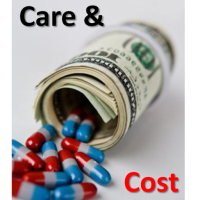Make Patient Care About Value, Not Volume – Care And Cost

Published May 8, 2021 in MedPage Today
Brian Klepper and Jeff Hogan
After the coronavirus pandemic and our stalled national economy, it is America’s runaway, intransigent, and immensely influential healthcare system that most urgently begs for the Biden administration’s close attention. The excesses that characterize U.S. healthcare — stratospheric unit pricing and wildly exorbitant overtreatment — are deeply entrenched, and make it an increasingly unaffordable burden; one that threatens our national economic security and our global competitive standing, diverting precious resources from other vital needs like education, transportation, and infrastructure.
For decades, healthcare inflation has risen at a multiple of general inflation so consistently that we now assume that’s the way it should be. In 2020, we spent about $11,100 per person on healthcare, slightly more than double the average spend in other developed countries. CMS predicts that by 2027, our annual healthcare spending will rise to about $17,500 per year per person or about a 60% increase over seven years. It is not just that much of American healthcare is inefficient; it’s that every part of the industry — supply chain, health information technology, care delivery, and finance — now depends on excessive care and costs to maintain the spectacular financial performance they have become accustomed to.
At the heart of America’s healthcare quality and cost crises is the corrosive way we pay for care. Decades of fee-for-service (FFS) reimbursement — paying piecemeal for healthcare procedures rather than for care bundles and their outcomes — have made it easy and lucrative to deliver more care rather than the right care. FFS pays for providing services, independent of outcome, which has inhibited innovation and protected the status quo, distorting our care and cost patterns and rendering them distinctly different than those in other developed countries.
In contrast, value-focused payment arrangements typically put providers at risk for their clinical and financial outcomes, and reward higher performance. These arrangements are a desirable approach from the purchaser’s perspective since paying for results disincentivizes unnecessary or poor quality care. For healthcare organizations to succeed with value-based payments, they typically must innovate, managing both clinical and financial processes. An incentive structure that rewards innovation and high performance would be transformative, rapidly revolutionizing virtually all of U.S. healthcare.
Much of the healthcare industry sees moving to value as a disastrous path that will reduce revenues and profitability. Despite a great deal of lip service acknowledging the need for a value-focus and more than a decade after the campaign for alternative payment models (APMs) began to get traction in the national conversation, the industry has dragged its feet and FFS still overwhelmingly dominates the payment landscape. In Xtelligent Healthcare Media’s recent Value-Based Care Assessment survey, half of the respondents (including 70% of physician practices) reported that more than 75% of their organizations’ revenues still come from FFS arrangements.
In other words, U.S. healthcare’s primary challenge is to overcome the health industry’s opposition and move healthcare’s incentive frame from volume to value.
One piece of good news is that healthcare clinical and financial management is experiencing a renaissance. Hundreds of new firms have emerged in the past several years that deliver measurably better health outcomes and/or lower costs than conventional approaches, particularly in high-value niches. Exciting new high-performance companies are gaining traction in musculoskeletal management, chronic disease management, specialty referral management, drug management, women’s health management, cancer management, high-acuity mental health management, and other costly areas.
Other good news — if it can be called that — is that purchasers’ restlessness has been exacerbated by the pandemic. Public entities’ tax bases have shrunk while healthcare costs have continued to rise. The big employers have awakened and employers of all sizes are hurting. These organizations simply don’t have the discretion or the resources to pay for unaccountable care. Many are finally receptive to direct contracting with proven non-conventional solutions that their health plan administrators, who make more if healthcare costs more, refuse to offer.
So, the future of U.S. healthcare is at a precarious moment. If campaign priorities were any indication, the Biden administration’s healthcare reform proposals will no doubt focus on finding better, more equitable ways to cope with healthcare’s existing structure. For their reform aspirations to be meaningful, though, that healthcare team must extend its reach and seek solutions that can bring U.S. healthcare back into balance as a core function that supports the American people.
Providers emerging from COVID-19 disruptions have faced an existential threat due to their reliance on volume-based reimbursements. The administration could sponsor programs that support greater organizational stability, as well as superior, predictable clinical and financial results. They could accelerate the drive to value and encourage providers to embrace risk, transforming their practices by treating patients as consumers and by integrating virtual care, behavioral health, and patient engagement into their platforms. The CMS Innovation Center Direct Contracting Initiative for primary care offers an example of a progressive risk-path supply chain model that incorporates these elements. It gives provider groups the opportunity to become dedicated to specific patients by using virtual capabilities, which will highlight the benefits of using technology for access and care coordination.
America should resist solutions that require even more money to pay for the current system. Instead, it should establish a process that methodically gets U.S. healthcare back to a system that serves rather than preys on its people. Reforms like this will require committing to a long-term plan, rewarding delivery of the right, most efficient care, and encouraging care and cost management processes that are accountable and predictable for patients and purchasers.
Dramatically better, less costly healthcare is well within reach of the American people. Getting there, though, will require a firm commitment to a value-focused health system payment structure that encourages innovation and high performance care. This is the way out of our current healthcare debacle.
Brian Klepper, PhD, is a healthcare analyst and principal of Worksite Health Advisors in Charlotte, North Carolina. Jeffrey Hogan is a health benefits advisor and principal of Upside Health Advisors in Farmington, Connecticut.
Published


